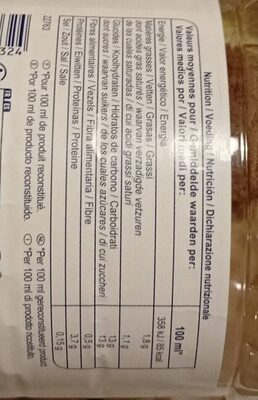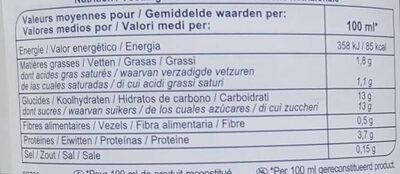Kaomix - Produits Blancs - 800 g
This product page is not complete. You can help to complete it by editing it and adding more data from the photos we have, or by taking more photos using the app for Android or iPhone/iPad. Thank you!
×
Some of the data for this product has been provided directly by the manufacturer Carrefour.
Barra-kodea: 3560071180324 (EAN / EAN-13)
Izen arrunta: Préparation en granulés pour boisson instantanée au cacao maigre.
Kopurua: 800 g
Markak: Produits Blancs, Carrefour
Kategoriak: en:Beverages, en:Breakfasts, en:Cocoa and its products, en:Frozen foods, en:Cocoa and chocolate powders, en:Instant beverages, en:Cocoa powders, en:Chocolate powders
Etiketak, ziurtagiriak, sariak: Nutriscore, Nutriscore B
Dendak: carrefour.fr, Carrefour
Matching with your preferences
Other information
Preparation: Versez le contenu de 2 à 3 cuillères à soupe de granulés (environ 20 g) dans un bol ou un grand verre. Ajoutez du lait demi-écrémé froid ou chaud mais non bouillant (environ 200 ml). Remuez, c'est prêt !
Conservation conditions: À conserver à l'abri de la chaleur et de l'humidité. Bien refermer le bocal après chaque utilisation. Pour une dégustation optimale, à consommer de préférence avant fin / N° de lot : voir sur le couvercle.
Customer service: Interdis - TSA 91431 - 91343 MASSY Cedex - France
Report a problem
Datuen iturria
Product added on by kiliweb
Last edit of product page on by kiliweb.
Produktuaren orria -gatik editatua chevalstar, driveoff, openfoodfacts-contributors, org-carrefour, quechoisir, roboto-app, segundo, yuka.UnFVOE43MGIrY0lvbWRzdTd4RHg5OUpUbnNPVVJYcVdNT014SVE9PQ, yuka.sY2b0xO6T85zoF3NwEKvlhRCWMfHvxnKCQH4mhXUw-and5XPYv1AzJXAGKo, yuka.sY2b0xO6T85zoF3NwEKvll1kePznm2zLNhXSu3GN94aDKYfTb9pu0477Lag, yuka.sY2b0xO6T85zoF3NwEKvllEXeeLVvi3jHCbnunKMwdmhc7Lue4sjzbWjDas, yuka.sY2b0xO6T85zoF3NwEKvllJhD_HwvAjuFEb5wGimz_2CM7HZONRp5YKmGKo, yuka.sY2b0xO6T85zoF3NwEKvllRebN2PryCZaQLvl3Cqm-_TK5DOY81U0rHxY6o, yuka.sY2b0xO6T85zoF3NwEKvlnBbAoXguz3ZOh_Vv1fUzfKlfsznS91D46rRAqs.










